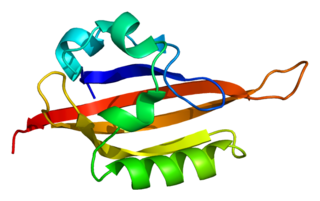Egl nine homolog 3 is a protein that in humans is encoded by the EGLN3 gene. [5] ELGN3 is a member of the superfamily of alpha-ketoglutarate-dependent hydroxylases, which are non-haem iron-containing proteins.
Egl nine homolog 3 is a protein that in humans is encoded by the EGLN3 gene. [5] ELGN3 is a member of the superfamily of alpha-ketoglutarate-dependent hydroxylases, which are non-haem iron-containing proteins.

(2S,4R)-4-Hydroxyproline, or L-hydroxyproline (C5H9O3N), is an amino acid, abbreviated as Hyp or O, e.g., in Protein Data Bank.
Hypoxia-inducible factors (HIFs) are transcription factors that respond to decreases in available oxygen in the cellular environment, or hypoxia.

Succinate dehydrogenase [ubiquinone] iron-sulfur subunit, mitochondrial (SDHB) also known as iron-sulfur subunit of complex II (Ip) is a protein that in humans is encoded by the SDHB gene.

The Von Hippel–Lindau tumor suppressor also known as pVHL is a protein that, in humans, is encoded by the VHL gene. Mutations of the VHL gene are associated with Von Hippel–Lindau disease, which is characterized by hemangioblastomas of the brain, spinal cord and retina. It is also associated with kidney and pancreatic lesions.

Hypoxia-inducible factor 1-alpha, also known as HIF-1-alpha, is a subunit of a heterodimeric transcription factor hypoxia-inducible factor 1 (HIF-1) that is encoded by the HIF1A gene. The Nobel Prize in Physiology or Medicine 2019 was awarded for the discovery of HIF.

Procollagen-proline dioxygenase, commonly known as prolyl hydroxylase, is a member of the class of enzymes known as alpha-ketoglutarate-dependent hydroxylases. These enzymes catalyze the incorporation of oxygen into organic substrates through a mechanism that requires alpha-Ketoglutaric acid, Fe2+, and ascorbate. This particular enzyme catalyzes the formation of (2S, 4R)-4-hydroxyproline, a compound that represents the most prevalent post-translational modification in the human proteome.

Endothelial PAS domain-containing protein 1 is a protein that is encoded by the EPAS1 gene in mammals. It is a type of hypoxia-inducible factor, a group of transcription factors involved in the physiological response to oxygen concentration. The gene is active under hypoxic conditions. It is also important in the development of the heart, and for maintaining the catecholamine balance required for protection of the heart. Mutation often leads to neuroendocrine tumors.

Hypoxia-inducible factor 3 alpha is a protein that in humans is encoded by the HIF3A gene.

Protein NDRG1 is a protein that in humans is encoded by the NDRG1 gene.

Egl nine homolog 2 is a protein that in humans is encoded by the EGLN2 gene. ELGN2 is an alpha-ketoglutarate-dependent hydroxylase, a superfamily of non-haem iron-containing proteins.

Hypoxia-inducible factor prolyl hydroxylase 2 (HIF-PH2), or prolyl hydroxylase domain-containing protein 2 (PHD2), is an enzyme encoded by the EGLN1 gene. It is also known as Egl nine homolog 1. PHD2 is a α-ketoglutarate/2-oxoglutarate-dependent hydroxylase, a superfamily non-haem iron-containing proteins. In humans, PHD2 is one of the three isoforms of hypoxia-inducible factor-proline dioxygenase, which is also known as HIF prolyl-hydroxylase.

Aspartyl/asparaginyl beta-hydroxylase (HAAH) is an enzyme that in humans is encoded by the ASPH gene. ASPH is an alpha-ketoglutarate-dependent hydroxylase, a superfamily non-haem iron-containing proteins.

Hypoxia-inducible factor 1-alpha inhibitor is a protein that in humans is encoded by the HIF1AN gene.

Protein OS-9 is a protein that in humans is encoded by the OS9 gene.
Hypoxia-inducible factor-proline dioxygenase (EC 1.14.11.29, HIF hydroxylase) is an enzyme with systematic name hypoxia-inducible factor-L-proline, 2-oxoglutarate:oxygen oxidoreductase (4-hydroxylating). This enzyme catalyses the following chemical reaction
Hypoxia-inducible factor-asparagine dioxygenase (EC 1.14.11.30, HIF hydroxylase) is an enzyme with systematic name hypoxia-inducible factor-L-asparagine, 2-oxoglutarate:oxygen oxidoreductase (4-hydroxylating). This enzyme catalyses the following chemical reaction:
hypoxia-inducible factor-L-asparagine + 2-oxoglutarate + O2 hypoxia-inducible factor-(3S)-3-hydroxy-L-asparagine + succinate + CO2
Alpha-ketoglutarate-dependent hydroxylases are a major class of non-heme iron proteins that catalyse a wide range of reactions. These reactions include hydroxylation reactions, demethylations, ring expansions, ring closures, and desaturations. Functionally, the αKG-dependent hydroxylases are comparable to cytochrome P450 enzymes. Both use O2 and reducing equivalents as cosubstrates and both generate water.
Christopher Joseph Schofield is a Professor of Chemistry at the University of Oxford and a Fellow of the Royal Society. Chris Schofield is a professor of organic chemistry at the University of Oxford, Department of Chemistry and a Fellow of Hertford College. Schofield studied functional, structural and mechanistic understanding of enzymes that employ oxygen and 2-oxoglutarate as a co-substrate. His work has opened up new possibilities in antibiotic research, oxygen sensing, and gene regulation.

WD repeat domain 83 is a protein that in humans is encoded by the WDR83 gene.

Prolyl 4-hydroxylase, transmembrane is a protein that in humans is encoded by the P4HTM gene.